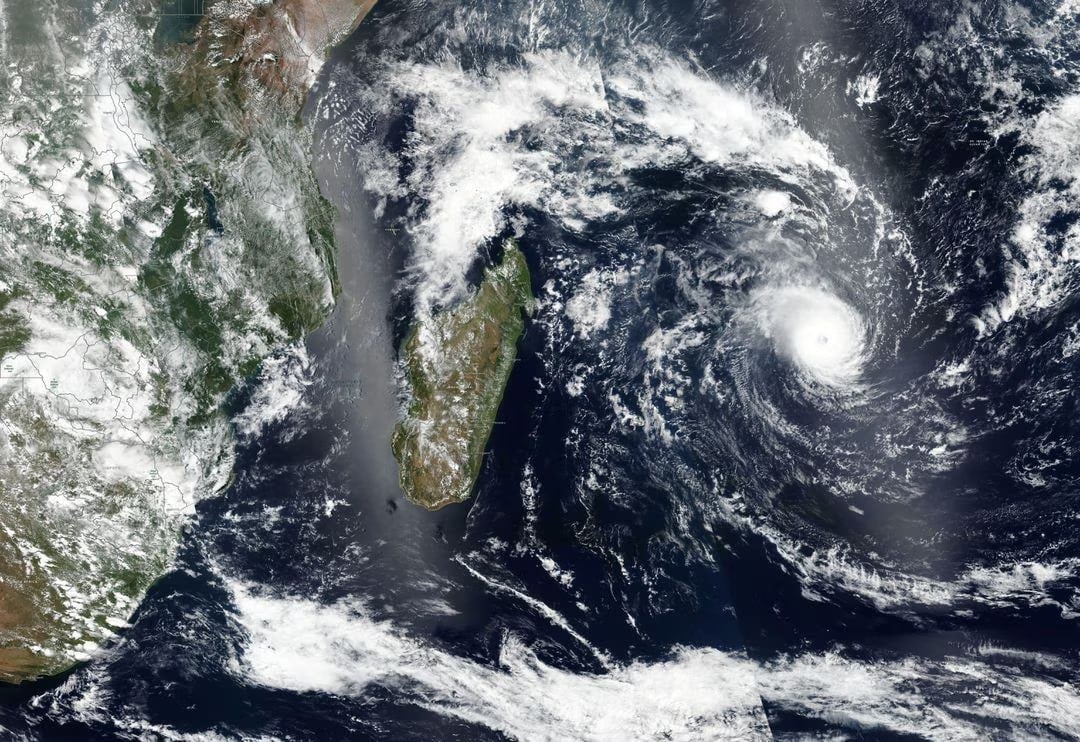Climate change doesn't cause storms, it strengthens them: Research
Tropical cyclones are ranked according to wind intensity, rising from tropical depression (under 63 kilometers per hour or 39 miles per hour), through tropical storms (63-117 kph) to major hurricanes (above that).
-

Satellite imagery shows Tropical Cyclone Freddy approaching Madagascar in this undated image obtained on February 20, 2023 (Reuters)
Climatologists and weather experts have debunked the myth that climate change makes cyclones and harsh storms occur more often. Instead, they stated that they make them more destructive and harsher.
They are called cyclones, hurricanes, or typhoons depending on the region they impact but are all violent tropical storms - that can generate energy 10 times as much as the Hiroshima atomic bomb.
Emmanuel Cloppet, of the French weather office Meteo France, told AFP: "A cyclone is a low-pressure system that forms in the tropics in an area hot enough for it to develop," adding: "It is characterized by rain/storm clouds that start rotating and generate intense rains and winds, and a storm surge created by the wind".
These huge weather phenomena are considered the more dangerous the more distance they are able to travel.
Tropical cyclones are ranked according to wind intensity, rising from tropical depression (under 63 kilometers per hour or 39 miles per hour), through tropical storms (63-117 kph) to major hurricanes (above that).
The most famous and used scale for measuring their intensity and potential to destruct is the five-level Saffir-Simpson wind scale.
According to World Weather Attribution (WWA), which is a group of climate scientists and specialists, "the overall number of tropical cyclones per year has not changed globally but climate change has increased the occurrence of the most intense and destructive storms".
Read more: New Zealand's Cyclone Gabrielle claims the life of 11
The WWA functions to show reliable links between global heating and some weather phenomena.
Categories 3 to 5 on the Saffir-Simpson scale, which are regarded as the most violent and destructive have been occurring more frequently, and the anthropogenic climate crisis influences them in three ways: by warming the air and oceans and by triggering a rise in sea levels.
"Climate change therefore creates the conditions in which more powerful storms can form, intensify rapidly and persist to reach land, while carrying more water," the WWA said.
In its publication "Reporting Extreme Weather and Climate Change", the WWA state that "tropical cyclones are the most extreme rainfall events on the planet," explaining that since the atmosphere is becoming warmer, it can hold more water meaning that's why it pours harshly when it rains.
"A rise in air temperature of three degrees Celsius (5.4 degrees Fahrenheit) can potentially produce a 20-percent increase in the quantity of rain generated by a cyclonic event," said Cloppet, who clarified that this is the reason why flash floods and mudslides occur and become fatal.
One example was Cyclone Freddy, which killed hundreds in Malawi and Mozambique this year.
Cyclone #Freddy is now the longest-lived tropical cyclone ever recorded WORLDWIDE! It’s trek across the entire Indian Ocean lasting an incredible 32 days, and counting! @weatherchannel pic.twitter.com/JWfsEyBJzT
— Scot Pilié (@ScotPilie_Wx) March 8, 2023
NASA has considered that Freddy holds the record for the highest accumulated cyclone energy (ACE) in the southern hemisphere. According to the World Meteorological Organization (WMO), Freddy was first detected off Australia's northern coast on February 6, then "crossed the entire South Indian Ocean."
Read next: UN report: Last 8 years were the hottest on record

 3 Min Read
3 Min Read









